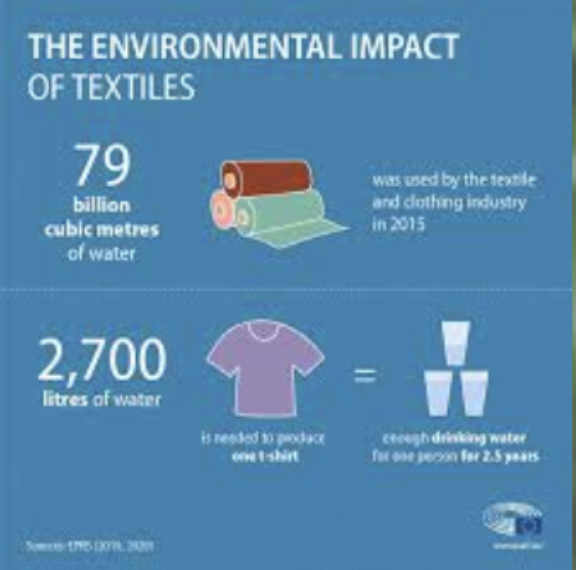Introduction to the Pillar
As Figures 1 and 2 show, sustainability is a big concern for the fashion industry since it plays such a strong role in the environment and in people. Fashion’s idea of the “planet” is an idea of protecting nature and being more responsible with resources. Hethorn and Ulasewicz (2015) report that sustainability involves three main areas: people, processes, and the environment. This means that real change does not necessarily stem from new technology but also from changing behavior, ethics, and the systems under which clothes are made. Resourceful management and reducing pollution are significant parts of this.
Circular Economy
The way in which clothes are made has a massive influence on the world. For example, treating and dyeing fabric tends to leak chemicals and microfibers into oceans and rivers, which tend to harm marine life. Figure 1 shows that to produce one cotton T-shirt, it requires around 2,700 liters of water as noted by the University of Waterloo (2019). Furthermore, demonstrates how dependent the industry is on freshwater. The circular economy is one solution to this problem. It is all about reducing, reusing, and recycling products instead of wasting them. The Ellen MacArthur Foundation (2017) has prompted brands like Burberry and Stella McCartney to embrace more sustainable manufacturing processes. MacArthur was motivated by her sailing around the globe and observing how the world was susceptible.
Sustainability in relation to fashion
Another method to promote sustainability is by using the 6Rs; rethink, refuse, reduce, repair, reuse, and recycle which assist in channelling more ethical design (Gwilt, 2014). Upcycling is increasingly being utilized by designers to create something new from leftover or second-hand clothes. Stella McCartney, for example, shows that luxury fashion can still be creative and fashionable without using leather, fur, or feathers.
UN SDG
United Nations Sustainable Development Goal 12, Sustainable Consumption and Production, also pertains to fashion because it involves sustainable production and honest communication (United Nations, 2015). Nevertheless, there remains greenwashing on a gigantic scale. Figure 2 shows that 96% of H&M’s claims about its sustainability were unproven or deceptive (Changing Markets Foundation, 2022), which undermines trust and is the opposite of what SDG 12 tries to accomplish.
Summary
Overall, Figures 1 and 2 show that fashion’s green footprint is still a massive problem. If the industry is to move forward, brands need to think beyond marketing speak and do some real, honest changes that are good for the planet.

Figure 2: Sustainability claims of fashion brands. Source: Changing Markets Foundation, 2021.

Figure 1: Water usage for a single cotton T-shirt. Source: University of Waterloo, 2019.
Bibliography
Ellen MacArthur Foundation, 2017. A new textiles economy: Redesigning fashion’s future. Cowes: Ellen MacArthur Foundation. [pdf] Available at: https://content.ellenmacarthurfoundation.org/m/6d5071bb8a5f05a2/original/A-New-Textiles-Economy-Redesigning-fashions-future.pdf [Accessed 10 October 2025].
Gwilt, A., 2014. Fashion design for living. London: Routledge. Available at: https://www.taylorfrancis.com/books/mono/10.4324/9781315779332/fashion-design-living-alison-gwilt [Accessed 10 October 2025].
Hethorn, J. and Ulasewicz, C., 2015. Sustainable fashion: What’s next? A conversation about issues, practices, and possibilities. 2nd ed. New York: Bloomsbury. Available at: https://www.bloomsbury.com/us/sustainable-fashion-whats-next-9781628925319/ [Accessed 10 October 2025].
United Nations, 2015. Goal 12: Responsible consumption and production. [online] Available at: https://sdgs.un.org/goals/goal12 [Accessed 10 October 2025].
University of Waterloo, 2019. Water Impact of Your T-shirt: 2700 litres! [online] Available at: https://uwaterloo.ca/engineering/events/water-impact-your-t-shirt-2700-litres [Accessed 10 October 2025].
Changing Markets Foundation, 2022. Synthetics Anonymous 2.0. [pdf] Available at: https://changingmarkets.org/wp-content/uploads/2022/12/Synthetics-Anonymous-2-online-reports-layout.pdf [Accessed 10 October 2025].
Leave a Reply